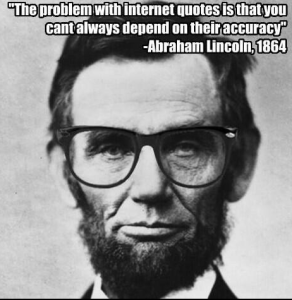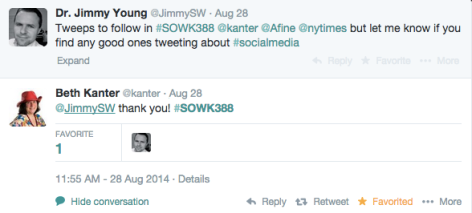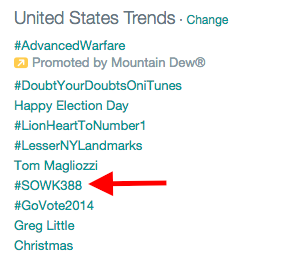I am presenting with Dr. Laurel Hitchcock at the Association of Baccalaureate Social Work Program Director’s Annual 2015 Conference on March 6, 2015 about our social media assignment designed for social work students to learn about and try their hand at macro- and policy-practice skills. In this workshop, we describe how we developed, implemented and assessed this assignment which incorporates a documentary movie with a live Twitter chat. We will discuss things we learned along the way and offer tips on how other educators can incorporate a similar assignment into their courses. The learning objectives for this session include:
- Understand how the social media platform Twitter can be incorporated into assignments for social work policy courses at the BSW-level.
- Demonstrate how social work educators can assess attainment of competency among BSW students using a social media assignment paired with a Rubric for evaluation of the assignment’s learning outcomes.
- Appreciate the role of professional collaboration in the development, implementation and assessment of social media-based assignments.
We have previously written about this assignment on our blogs:
- Special #MacroSW Chat October 28th at 8pm CST from JimmySW’s Blog:
https://jimmysw.wordpress.com/2014/10/03/special-macrosw-chat-october-28th-at-8pm-cst/
- Follow-up to 10/28 #MacroSW Twitter Chat from Teaching Social Work Blog:
http://www.laureliversonhitchcock.org/2014/11/07/follow-up-to-1028-macrosw-twitter-chat/
Here is a link to the Prezi that we will show during the presentation (http://tiny.cc/SMAssignment_BPD2015).
Our next live Twitter chat for this assignment will be on March 12, 2015 9 PM EST/8 PM CST and we invite you all to join us. The chat is sponsored by #MacroSW. Click here for more details.
Finally, here is the abstract for our presentation:
Social media includes applications, digital technologies, and mobile devices that utilize the Internet in a manner to create an interactive dialogue among organizations, communities, and individuals (Richardson, 2006). More specifically, social media are defined as an array of digital technologies that allow for the creation and exchange of user generated content (Kaplan & Haenlein, 2010; Kanter & Fine, 2010). Irrespective of the variety of terms and definitions, the role of the user as an active participant of interaction with others is paramount when describing social media (Kilpelainen, Paykkonen, & Sankala, 2011). There is a growing awareness that social work practitioners, students and educators need to be adept at using social media and information communication technology as part of their practice and interaction with clients and organizations of all sizes (Coe Regan & Freddolino, 2008; Getz, 2012; National Association of Social Workers [NASW], 2005). However, technology in social work education has been integrated sporadically with varying degrees of success, and the literature suggests social work educators need to increase their digital competencies or media literacy while carefully considering how and why to integrate technology into their courses and curricula (Hitchcock & Battista, 2013; Straub, 2009; Young, 2014). By doing so, educators can play a pivotal role in helping students to increase their own media literacy, and ultimately apply this knowledge to their own learning and subsequent practice.
This workshop will inform participants about the development, implementation and assessment of a social welfare macro/policy assignment for BSW students using the microblogging platform, Twitter and a documentary film. The assignment involves social work students from four different universities spread across different parts of the country using Twitter to participate in a live chat about a macro/policy issue highlighted in the film, and is embedded as part of a policy and or macro-practice course. Through the assignment, students actively engage in competency-based practice behaviors connected to professional behavior, policy practice and critical thinking while also increasing digital media literacies (CSWE, 2008). Specifically, students are able to use critical thinking augmented by creativity and curiosity to convey their thoughts and reactions to the issue being highlighted (EPAS 2.1.3), and students understand that policy affects service delivery. Students are able to engage in policy practice through this assignment by collaborating with others to advocate for policies that advance social well-being (EPAS 2.1.8).
Student assessment of competency attainment is achieved through a rubric designed specifically for the assignment and implemented across multiple classrooms. Rubrics have been increasingly used to evaluate and promote student learning (Gezie, Khaja, Chang, Adamek, & Johnsen, 2012; Stevens, Levi, & Walvoord, 2012). The presenters will share their experiences in designing and executing the assignment along with data demonstrating how the assignment’s rubric assessed student achievement of social work competencies. Lessons learned from the project will be shared and implications for the implicit curriculum will be reviewed.
References:
Coe Regan, J. A., & Freddolino, P. P. (2008). Integrating technology in the social work
curriculum. Alexandria, VA: Council on Social Work Education.
Council on Social Work Education. (2008). Educational Policy and Accreditation
Standards. Washington, DC: Author.
Getz, L. (2012). Mobile App Technology for Social Workers. Social Work Today, 12 (3), 8 -10.
Gezie, A., Khaja, K., Chang, V. N., Adamek, M. E., & Johnsen, M. B. (2012). Rubrics as a Tool for Learning and Assessment: What
do Baccalaureate Students Think? Journal of Teaching in Social Work, 32(4), 421-437.
Hitchcock, L. I., & Battista, A. (2013). Social Media for Professional Practice: Integrating Twitter with Social Work Pedagogy. The Journal of
Baccalaureate Social Work, 18(special issue), 33-45.
Kanter, B., & Fine, A. H. (2010). The networked nonprofit: Connecting with social media to drive change. San Francisco, CA: Jossey-Bass.
Kaplan, A. M., & Haenlein, M. (2010). Users of the world, unite! The challenges and opportunities of Social Media.
Business Horizons, 53, 59-68.
Kilpelainen, A., Paykkonen, K., & Sankala, J. (2011). The use of social media to improve social work education in remote areas. Journal of
Technology in Human Services, 29(1), 1-12.
NASW (National Association of Social Workers)/ASWB (Association of Social Work Boards).
(2005). NASW & ASWB Standards for technology and social work practice. Retrieved on July 30, 2012 from http://www.socialworkers.org/practice/standards/NASWTechnologyStandards.pdf.
Richardson, W. H. (2006). Blogs, Wikis, Podcasts, and Other Powerful Web Tools for Classrooms. Thousand Oaks, CA: Corwin Press.
Stevens, D. D., Levi, A. J., & Walvoord, B. E. (2012). Introduction to Rubrics: An Assessment Tool to Save Grading Time, Convey Effective
Feedback, and Promote Student Learning (2nd edition.). Sterling, VA: Stylus Publishing.
Straub, E. T. (2009). Understanding Technology Adoption: Theory and Future Directions for Informal Learning. Review of Educational
Research, 79(2), 625–649.
Young, J. (2014). iPolicy: Exploring and Evaluating the use of iPads in a Social Welfare Policy Course. Journal of Technology in Human
Services, 32(1-2), 39-53.











